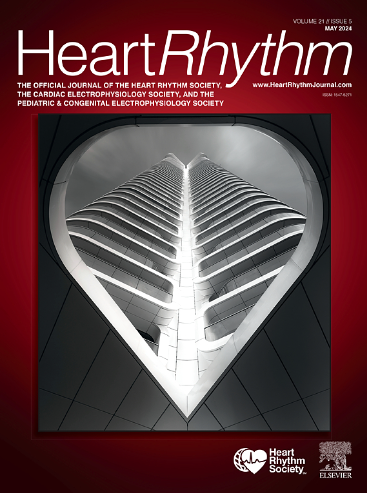Uniform slow conduction during sinus rhythm and low voltage/low voltage gradient ΔV/V characterize the VT isthmus location
IF 5.7
2区 医学
Q1 CARDIAC & CARDIOVASCULAR SYSTEMS
引用次数: 0
Abstract
Background
Reentrant ventricular tachycardia (VT) properties require further elucidation.
Objective
To understand circuit mechanisms and improve ablation targeting.
Methods
In postinfarction VT patients undergoing electrophysiology study and catheter ablation, high-density endocardial electrogram contact mapping data was acquired during sinus rhythm (n = 6) and during VT (n = 12) and annotated by the system. Bipolar endocardial VT voltage was used to compute the voltage gradient, ΔV/V, at isthmus midline and at the lateral boundaries. Voltage was additionally represented as a depth as well as a color change, to better visualize level. Linear regression analysis was implemented to quantitate the sinus rhythm activation gradient along the isthmus long-axis midline, and along 3 other spokes originating from a last activation point.
Results
The mean voltage along the isthmus long-axis was 0.234 ± 0.137 mV, vs 0.383 ± 0.290 mV aside boundaries (P < .001). The gradient ΔV/V along the isthmus long-axis was 0.425 ± 0.324, vs 0.823 ± 0.550 at boundaries (P < .001). Sinus rhythm activation was uniform (mean r2 = 0.93 ± 0.05) and slow (∇ = 0.16 ± 0.03 mm/msec) along the spoke coinciding with isthmus long-axis midline, vs less uniform (mean r2 = 0.32 ± 0.25) and rapid (∇ = 0.73 ± 0.62 mm/msec) along the other spokes (P < .001 and P = .003, respectively). Plotting r2 vs ∇, parameters of isthmus vs nonisthmus spokes were clearly separable.
Conclusion
A low-voltage trench coincides with the VT isthmus, vs abrupt voltage increase at the lateral boundaries, which may contravene prior definitions of conducting channels. Sinus rhythm uniform slow conduction occurs at the VT isthmus location, preventing circuit disruption while enabling the formation of an excitable gap to perpetuate reentry.
窦性心律时均匀缓慢的传导和低电压/低电压梯度ΔV/V是VT峡部位置的特征。
背景:重入性室性心动过速(VT)的特性需要进一步阐明。目的:了解回路机制,提高消融靶向性。方法:对接受电生理研究和导管消融的梗死后室速患者,在窦性心律(N=6)和室速(N=12)期间获取高密度心内膜电图接触测绘数据,并进行系统注释。采用双极心内膜VT电压计算峡部中线和外侧边界的电压梯度ΔV/V。电压还被表示为深度和颜色变化,以更好地可视化水平。采用线性回归分析,量化了沿峡长轴中线和从最后一个激活点出发的其他三个辐条的窦性心律激活梯度。结果:沿峡长轴的平均电压为0.234±0.137 mV,沿边界的平均电压为0.383±0.290 mV (p < 0.001)。沿峡长轴的梯度ΔV/V为0.425±0.324,边界处为0.823±0.550 (p < 0.001)。在与峡长轴中线重合的辐条上,窦性心律激活均匀(平均r2=0.93±0.05)且缓慢(∇=0.16±0.03 mm/msec),而在其他辐条上,窦性心律激活不均匀(平均r2=0.32±0.25)且快速(∇=0.73±0.62 mm/msec) (p2 vs∇),峡与非峡辐条的参数可明显分离。结论:低电压沟槽与VT峡重合,而在侧边界电压突然升高,这可能与先前的传导通道定义相矛盾。窦性心律均匀缓慢传导发生在室速峡部,防止电路中断,同时使可兴奋间隙的形成使再入永久存在。
本文章由计算机程序翻译,如有差异,请以英文原文为准。
求助全文
约1分钟内获得全文
求助全文
来源期刊

Heart rhythm
医学-心血管系统
CiteScore
10.50
自引率
5.50%
发文量
1465
审稿时长
24 days
期刊介绍:
HeartRhythm, the official Journal of the Heart Rhythm Society and the Cardiac Electrophysiology Society, is a unique journal for fundamental discovery and clinical applicability.
HeartRhythm integrates the entire cardiac electrophysiology (EP) community from basic and clinical academic researchers, private practitioners, engineers, allied professionals, industry, and trainees, all of whom are vital and interdependent members of our EP community.
The Heart Rhythm Society is the international leader in science, education, and advocacy for cardiac arrhythmia professionals and patients, and the primary information resource on heart rhythm disorders. Its mission is to improve the care of patients by promoting research, education, and optimal health care policies and standards.
 求助内容:
求助内容: 应助结果提醒方式:
应助结果提醒方式:


